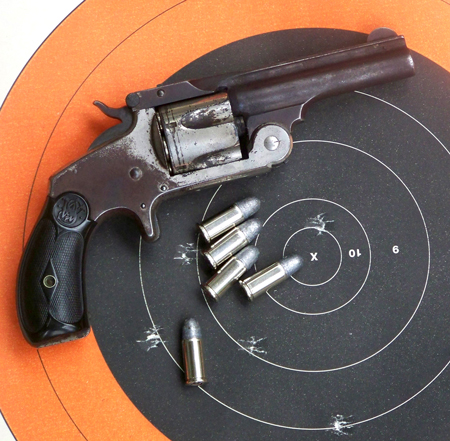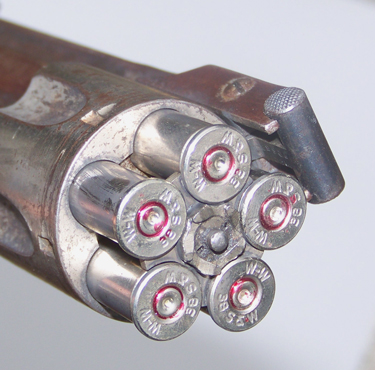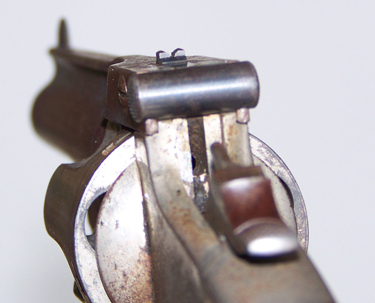
And you might even find a Smith & Wesson Single Action or two. The fact is, Smith & Wesson marketed a perfectly good line of self-defense revolvers as early as 1876 and produced nearly 160,000 of them before dropping the design in 1911.
Now, Colt produced 357,859 First Generation Single Action Army revolvers between 1873 and 1940. This means that Smith & Wesson sold nearly 45 percent as many Single Action .38s as Colt did its First Generation Single Action Army — and the Colt was in production for 32 years longer than the S&W. But who today remembers the S&W .38 Single Action? Durn few of us, that’s who.
The S&W .38 Single Action deserves to be remembered today, not just because it was a big seller in its time but because it was the first gun to chamber one of the best-natured revolver cartridges of all time: the .38 S&W. (Today, the .38 S&W bears the distinction of being the third-oldest continuously-produced American centerfire handgun cartridge, right after the .45 Colt and the .44-40 Winchester.)
The story of the S&W .38 Single Action begins way back in 1855, when Horace Smith and Daniel B. Wesson teamed up to form the Volcanic Repeating Arms Company to produce the Volcanic lever-action pistol.

This odd arm, originally designed by a Yankee mechanic named Walter Hunt, eventually morphed into the famed Henry rifle and then into the even more famous Winchester Model 1866. The Volcanic pistol, however, never succeeded in the marketplace, and by 1856 Horace and Daniel were forced to sell the company to majority stockholder Oliver Winchester. They bounced right back, however, and immediately formed the company we know today as Smith & Wesson.
Smith & Wesson’s first product, the Model 1 .22 revolver of 1857, was a ridiculously dinky thing to base a firearms empire on. Chambered in the .22 Short and hinged at the top of the frame rather than the bottom, it was designed with a bored-through cylinder, a patented feature that made it quite unique and kept Colt’s hands — and every other competitor’s, too — firmly tied until 1872. Though absurdly underpowered, the little Model 1 was a best-seller, with around 270,000 in all six types and three issues being sold by 1868.
Obviously, though, you couldn’t make a decent buck piddling around with .22 rimfires, so in 1870 Smith & Wesson introduced a massive .44 centerfire single-action, the Model 3 American. Chambered for a pleasingly stout cartridge called the .44 American, the Model 3 was a revolutionary departure for S&W, featuring a break-open frame with the hinge at the bottom and the latch at the top. The big .44 also featured automatic ejection of empty cases, quite a novelty in itself.
You’d think that a revolver like the Model 3 American would become a smash hit. In fact, S&W sold around 32,000 of them in two models in the four years between 1870 and 1874 and then pulled the plug on the American. Why? Ask Czar Alexander II.
In 1871, the Czar gave S&W an order for 20,000 of the big .44 revolvers which, with minor modifications, became known as the Model 3 Russian. Production of this huge revolver ceased in 1878 with around 168,000 in three major variations produced just for the Russians alone. This explains why large-frame S&W revolvers weren’t more common on the frontier: most of S&W’s production capacity was tied up with the Russian order for most of a decade.
In 1876, however, S&W put a new medium-sized revolver into production, one that shared so many of the Model 3 Russian’s features that it has been known ever since as the “Baby Russian.” Its actual designation was the .38 Single Action 1st Model.
Like its big brother the .44 Russian, the .38 Single Action was a hinged-frame, top-break revolver with automatic ejection. The resemblance pretty much stops there, however. Whereas the .44 was a six-shooter, the Baby Russian was a five-shooter. The .44 had a trigger guard; the .38 had a spur trigger. There were also numerous differences in the number and placement of sideplate and frame screws, in the grips, and in the angle of the grip frame.
But no matter: The “Baby Russian” it was called and the “Baby Russian” it would remain. To be entirely accurate, and with all due deference to serious S&W collectors, only the .38 Single Action 1st Model (1876 – 1877) is properly termed the Baby Russian; the 2nd Model (1877 – 1891) and 3rd Model (1891 – 1911) are called the plain old .38 Single Action, 2nd and 3rd Models. (The 3rd Model is the only one of the three to have a trigger guard.) Yet another variant, the rare Mexican Model, was basically a 3rd Model but had a spurred trigger guard and no half-cock notch.
In 1911, S&W finally bade goodbye to its single-action line. Various Lemon Squeezers and Hand Ejectors had finally rendered the .38 Single Action quite obsolete, and it would be 50 years before Smith & Wesson produced another single action, the special-order K-38 Target Masterpiece Single Action of 1961.

My S&W .38 Single Action is a well-worn 2nd Model that I got for a song (“You’re A Grand Old Flag” in the key of G) from Phillip Peterson. Mine has the 3.25-inch barrel, although the 2nd Model was also available with barrels of 4, 5, 6, 8 and 10 inches. Mine was originally 100 percent finished in nickel, as most 2nd Models were, but now it’s down to about 50 percent. Its grips are plain old hard rubber with the S&W logo molded into them.
Between 1877 and 1891, S&W made 108,225 .38 Single Action 2nd Models. Mine has a serial number of 72,000-and-something, which places it numerically at the tail end of the third quarter of the overall production run. We’ll take a SWAG and assign it a production date of 1886 or thereabouts.
So here we have a 122-year-old revolver, and it shoots like it just left the factory. I can find no evidence that the sideplate has ever been removed or that the gun has ever been monkeyed with. The springs are still admirably strong, the ignition absolutely certain and the lockup as tight as I could want. Cylinder endshake is zero. The trigger breaks cleanly at just over 3 lbs., which is a bit heavier than I’d like, but then again I shouldn’t be so critical. The gun was made during Grover Cleveland’s first term, for Pete’s sake.
With its spur trigger and minuscule rear sight notch, the 3.25-inch-barreled .38 Single Action was obviously intended as a pocket pistol, so I fired it offhand at a measured 7 yards at a paper target to see if it could still perform. With new-production Remington ammunition, my first group was just over 5 inches, which says something about old-time Smith & Wesson quality. I don’t think the .38 Single Action will replace my Kel-Tec as a carry gun, but it could do quite nicely in a pinch, I think.
Those who have a Smith & Wesson .38 Single Action would do well to have it checked out by a competent gunsmith before firing it. Ammunition loaded with the original 146-grain lead round-nose is still manufactured by Remington and Winchester. You might also find suitable older ammunition labeled .38 Colt New Police, which was a proprietary version loaded with a flat-pointed lead bullet. I would probably avoid the .38 S&W/.38 Colt Super Police load, a scarce item that packed a hemispherical 200-grain lead bullet. I’ve shot the Super Police load in a small top-break revolver before, and doing so struck me at the time as both unsafe and foolish. Its recoil was rich in testosterone.
Condition collectors will undoubtedly spit all over me for saying this, but I like my .38 Single Action 2nd Model despite its dilapidated finish. It loads, fires and ejects as well as it did back in 1886. I just hope I’m in as good a shape on my 122nd birthday!
This article appeared in the January 4, 2010 issue of Gun Digest the Magazine.

Next Step: Get your FREE Printable Target Pack
Enhance your shooting precision with our 62 MOA Targets, perfect for rifles and handguns. Crafted in collaboration with Storm Tactical for accuracy and versatility.
Subscribe to the Gun Digest email newsletter and get your downloadable target pack sent straight to your inbox. Stay updated with the latest firearms info in the industry.

![Best Concealed Carry Guns In 2025 [Field Tested] Wilson Combat EDC X9S 1](https://gundigest.com/wp-content/uploads/Wilson-Combat-EDC-X9S-1-324x160.jpg)


![Best 9mm Carbine: Affordable PCCs [Tested] Ruger Carbine Shooting](https://gundigest.com/wp-content/uploads/Ruger-Carbine-Shooting-100x70.jpg)
![Best AR-15: Top Options Available Today [Field Tested] Harrington and Richardson PSA XM177E2 feature](https://gundigest.com/wp-content/uploads/Harrington-and-Richardson-PSA-XM177E2-feature-100x70.jpg)

I am curious. I bought one of these .38 single actions. Not knowing anything about it other than it’s a Smith &, Wesson .38. How do I figure out which model it is?